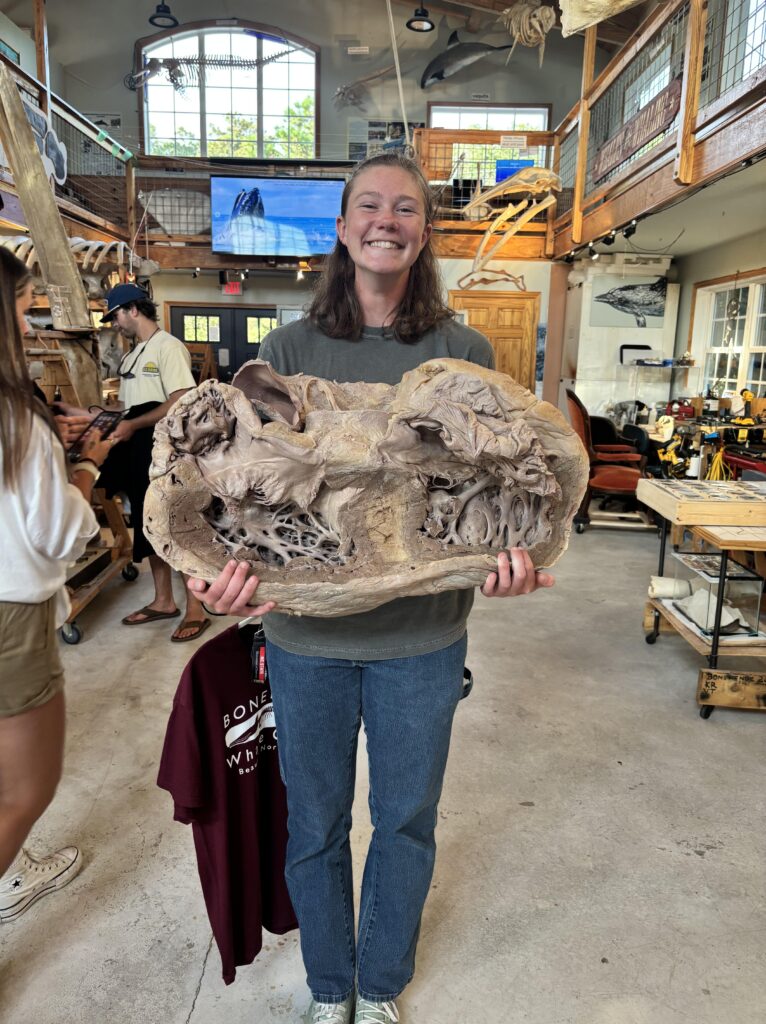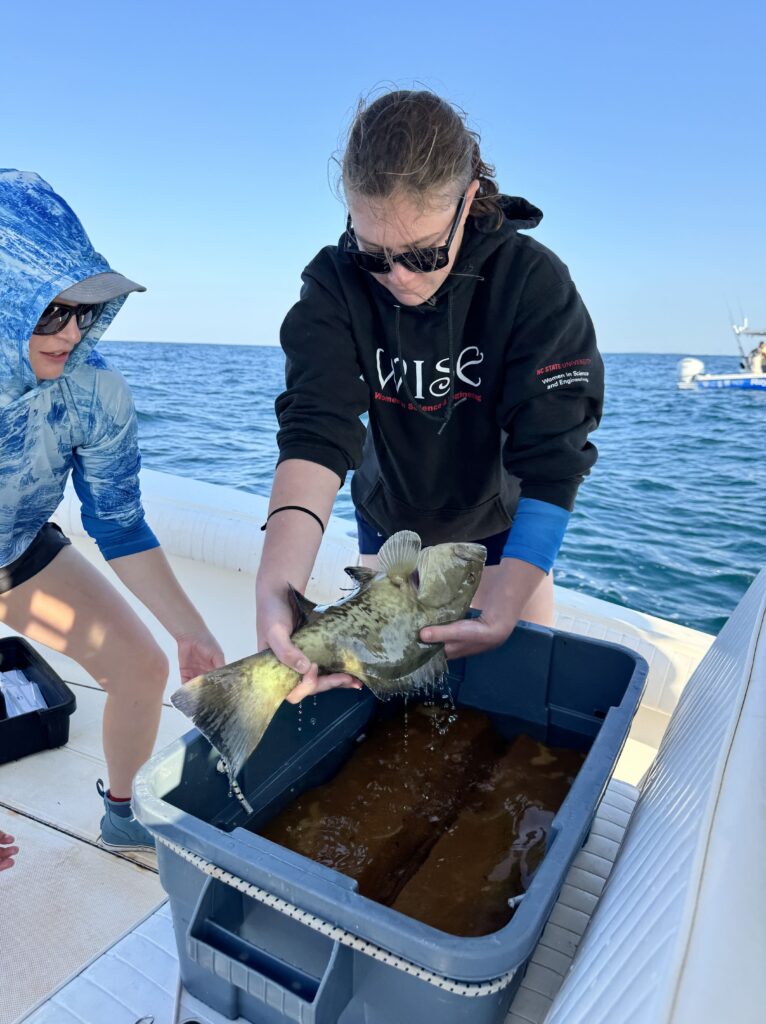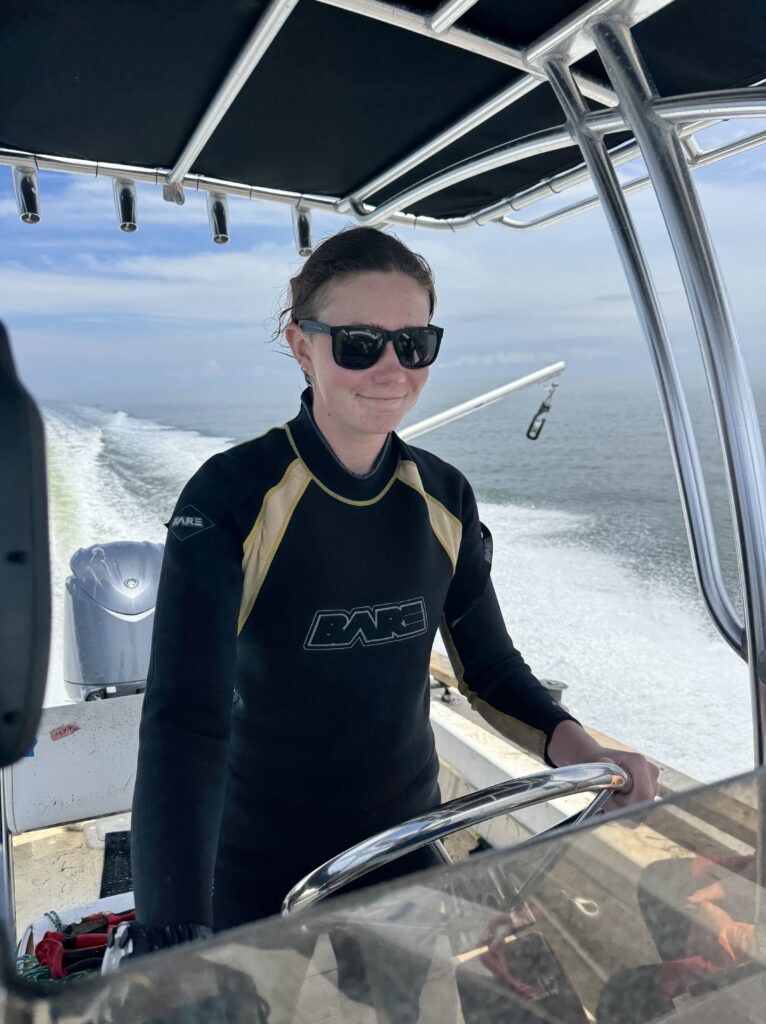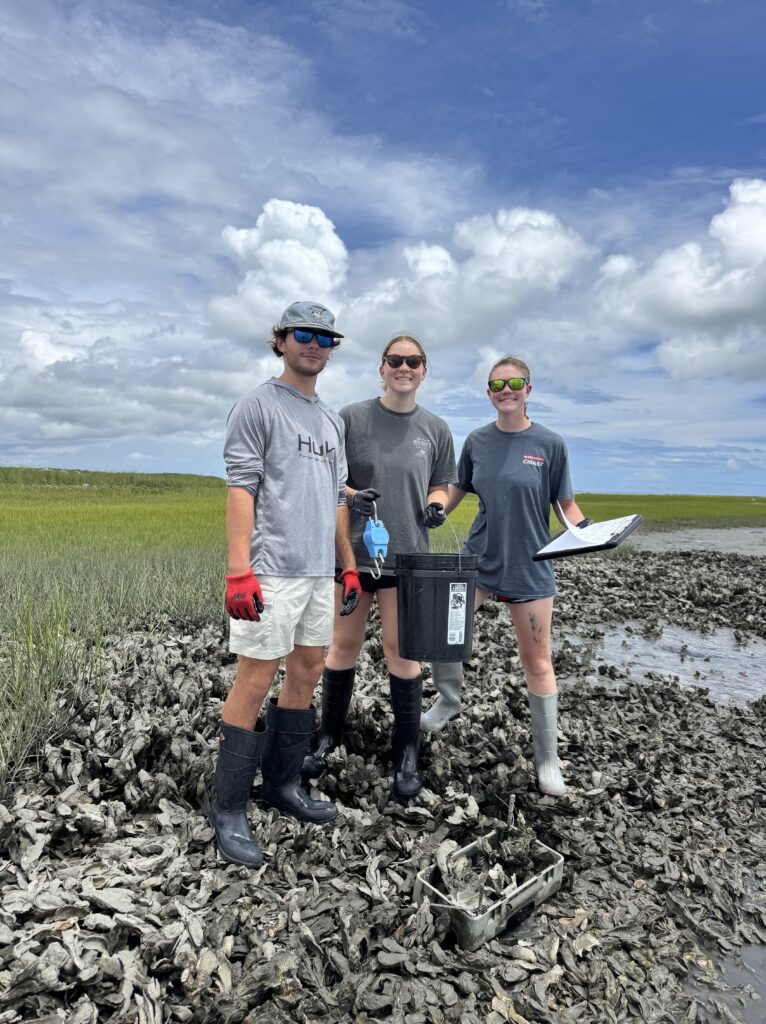Meet Bryn Fleming, NC State’s Newest NOAA Hollings Scholar
Rising junior Bryn Fleming is NC State’s latest recipient of the Ernest F. Hollings Undergraduate Scholarship, awarded by the National Oceanic and Atmospheric Administration (NOAA). The prestigious scholarship includes a two-year academic scholarship, a paid summer internship opportunity and funding to participate in two national scientific conferences, according to NOAA.
Fleming joins a cohort of 130 undergraduates across the country who were selected for the scholarship, which saw more than 800 applicants last year.
Fleming joined NC State University in 2023 with a strong background in marine science, having grown up in Morehead City, North Carolina. The area is home to an abundance of nearby marine labs, such as the NOAA Beaufort Laboratory and NC State’s Center for Marine Sciences and Technology (CMAST). That environment, plus her parents’ own marine science careers, led the rising junior to pursue majors in chemistry and chemical oceanography at NC State.
Get to know Bryn Fleming in the Q&A session below.


First, let’s talk about your majors. What are you passionate about in your fields of study?
If I were going to be a pure chemist, I would be an analytical chemist. I want to look at analyzing trace compounds and figuring out how to measure them, and figuring out how to measure them accurately.
What drew me to chemical oceanography is that I really like the intersection of analytical chemistry and the environment. I’m very passionate about wells and fresh water, and making sure people have fresh water. That involves testing well water for saltwater intrusion or PFAS intrusion.
I’m also very interested in looking at the effects of runoff and chemical companies that may be dumping their waste product into the ocean or the nearest water body. I’m interested in seeing the effects of those chemicals and pollutants on the environment and developing new regulations to make sure that they don’t harm the environment—at all, if possible.
If someone has heard of chemistry, but hasn’t heard of chemical oceanography, how would you describe it?
Chemical oceanography is pretty broad, like most oceanographical disciplines. The way that I think about it is that it’s related to a lot of nutrient cycling. You have the carbon, nitrogen and phosphorus cycle—that’s all a chemical process.
It also looks at a lot of fertilizers, minerals, runoff, and if there’s pollution from any of those. Cleanup with oil spills—that’s also chemical oceanography. Looking at PFAS and microplastics—that’s chemical oceanography because you can see what is in the ocean that is causing these microplastics to break down. To summarize, it would be looking at all of the different compounds that are in the ocean, how they affect the ecosystem and how they interact with each other.
Turning to your scholarship now, how did you first hear about the Hollings scholarship?
I actually heard about it through a friend of mine. We were in the same science diving group in high school, and he told me about it, I think, during my freshman year, except it is specifically for rising juniors. So, because of that requirement, I didn’t apply to it when he told me about it.
I waited until I was in the right year of school, and then I had a couple of really lovely and encouraging professors who were able to write recommendation letters for me; Dr. Chris Osburn, who’s in MEAS—he is my advisor in that program—and then Dr. Carli Arendt. She taught my geochemistry of natural waters class the fall of my sophomore year, and I really liked her, and she was willing to write a letter of recommendation for me, which I was really grateful for.
How did it feel to be selected for the scholarship?
With both the nature of the scholarship being as selective as it is, and also the general atmosphere around funding and NOAA, I was just like, ‘Yeah, that’s not going to happen. I’ll apply to it on the off chance that I’ll get it, but there’s literally no way.’
I was in quant lab—quantitative chemistry—and I checked my email while we were running something, and they were like, ‘Congratulations!’ I had no idea, no expectation. I almost cried. I didn’t, because I was in lab and had goggles on, but I was astounded.
As part of the scholarship, you’ll be interning with NOAA next summer, correct?
Yes! The general way that it works is that everybody who has a lab in a NOAA facility puts whatever project they’re working on into this database, and then that opens for us. You look through the database, make a note of everything that you’re interested in, and then once you’ve found a project that’s the one you want to do, you reach out to the PI. You talk with them, see if they’re a good fit, and then typically you’ll do a site visit that’ll kind of finalize it.
Alternatively, if you know of a professor and they haven’t listed a program, or if you know of a professor and you’re just really interested in their work, you can set something up outside of that database. Then it gets entered into the database to make it official.
That’s typically how that works. It’s nine or 10 weeks. I could go to Alaska. I could go to Hawaii. I could go to California—anywhere that there is a NOAA lab.
How do you anticipate this scholarship will support the rest of your college career?
I have always been really interested in working for NOAA. Like I said, there’s a NOAA lab where I grew up. A bunch of my parents’ friends are NOAA people. I always wanted to do something like that.
I would really like to work, honestly, at the Beaufort Lab. I’d need to get experience with other labs, but a lot of the work that they do with harmful algal blooms and pollution mitigation is something that I would like to do or expand upon if I were given the opportunity. So, it’s a definite leap in the right direction for me.
In addition to your scholarship, you’re also a CMAST Summer Research Fellow. Could you talk about what you do in that role?
I’m working with Dr. David Eggleston and Melissa LaCroce, and then also Emory Harned. He’s one of the other CMAST fellows, and we’re cooperating on an oyster project.
The main thing that we do is look at oyster health and the Pamlico Sound. Emery’s project is comparing two different sanctuaries that were recently established, and then I’m looking at a time series of water quality data and a time series of oyster growth and performance data from the same timeframe. I’m trying to compare them and correlate different water quality variables, like salinity, dissolved oxygen, chlorophyll-a concentration and temperature. I’m trying to correlate those to oyster performance.
I’m also comparing that dataset to an HSI that was made a few years ago. ‘HSI’ means habitat suitability index. That’s basically indexing a bunch of these variables, not only the four that I mentioned. You’re basically outlining where in the Pamlico Sound would be most ideal to set up new sanctuaries. I’m comparing my oyster data to build a predictive model, and I’m also comparing that to the HSI to see if that matches the results of some of these new sanctuaries that were built last year.
I’ve also gotten to do a bunch of other really cool stuff. I’ve done turtle necropsies. I’ve done dolphin necropsies. We followed some horses around for a day and waited for them to poop because they were doing a diet study on lactating mares. We went to Bonehenge. We do a bunch of cool things. So, I have my own project, and then we circulate and help out all of the other labs that need help, or we think their work is cool and want to be involved.


It sounds like there’s not a typical day at CMAST, that it can be quite variable.
Oh, it is. There are three types of days, I would say. There are computer days, so I’m working on my project and I’m entering data. We also have boat days, so we will take the boat out. Normally we are deploying instrumentation, checking instrumentation, recovering instrumentation and oyster sampling. We’ve done a lot of that, and then we’ll take the oysters back to the lab and measure them and do whatever we need to with them. Then there are also project days, so turtle necropsies, going to Bonehenge, stuff like that.
My internship ends next Friday, and then we have a final presentation Thursday, so not that much longer.
What are your future aspirations?
My long term plans are still pretty vague given I’m a rising junior, but my current plans are to get a master’s right out of undergrad. I’m thinking about doing that here. I have a project in mind relating to chlorophyll and the Pamlico Sound, and how its various sources affect the ecosystem. That would be really cool.
Then, maybe I’ll work for NOAA. I’d also like to work at the EPA. I’d like to work at a regulatory agency, and I’d like to do large volumes of data accumulation and processing. I know that a lot of people have time series datasets of water quality and stuff like that that gets collected but doesn’t necessarily get used. So, I would like to start looking at those datasets, or maybe building new datasets and trying to develop better regulations and put better monitoring efforts into place. That’s so the beaches are more safe, the water sources that we have are more safe—just making sure that our water is safe in general, and that the ecosystem that depends on that water is not being threatened by something in it.
I do want to say that I’m really grateful for everybody who has supported me and made this possible. I’m really grateful to the professors who wrote my letters of recommendations and everyone at CMAST who has inspired me to do a master’s in the first place, and all of the faculty and students who I’ve met who have helped shape what I see for myself in the future.
I’m really grateful to all of the people around me—and my mom! I can’t forget my mom. She will never let me forget it. I am so grateful to my mom and my dad. They have supported me my entire life, and they have encouraged me to pursue my passions and interests, and they have provided me with the tools to choose my own future.
This post was originally published in Department of Marine, Earth, and Atmospheric Sciences.